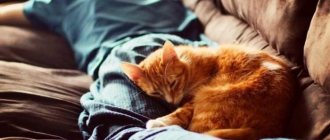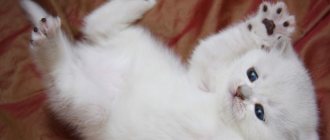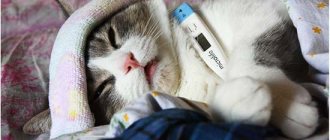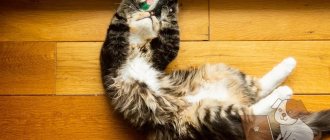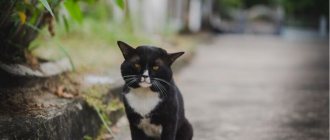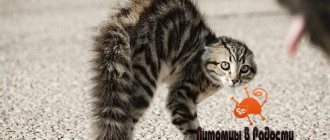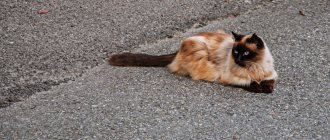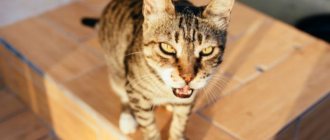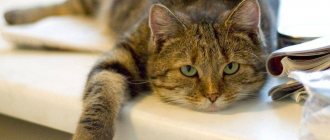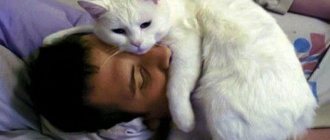If your cat is rolling on her back, she is either motivated by something or is experiencing discomfort. Naturally, it is better for the owner to understand the reasons, since mild discomfort tends to transform into an ailment that is difficult to cure.
This is interesting! There is a sign that a cat rides on its back before a snowstorm.
The language of cats. How to understand your pet.
The cat has turned away from you - it doesn’t want to communicate.
The cat is stretched out in front of you and is in a relaxed state - she feels free and comfortable.
The cat turned over on its back - it was relaxed and in a good mood.
The cat hisses, arches its back - it is defending itself.
The cat lies down on the ground, lowers its head, presses its ears to its head, wags its tail - the cat is scared.
A cat clinging to the ground, purring, pressing its tail to its body or waving it is excited and hostile.
The cat looks at you for a few seconds and then turns away, which means it recognizes you as the owner, but does not want to communicate at the moment.
A long, persistent, gaze is a threat, a warning.
The cat's pupils are dilated, eyes wide open - fear.
Ears upright - curiosity, joy, playfulness.
Ears pointed to the sides - fear, mistrust, protection.
Ears are directed back and pressed to the head - panic, readiness to attack, aggression.
The tail is pointed upward - self-confidence, importance. The tail is fluffed - feigned courage and fear
The tail is fluffed - feigned courage and fear.
Slow tail flicks indicate mild irritation.
The tail swings sharply from side to side - anger, warning of an attack.
Frequent twitching of the tip of the tail indicates interest, attention, readiness to hunt. A third eyelid has appeared - the cat is sick or wants to sleep
A third eyelid appears - the cat is sick or wants to sleep.
Mustaches down - concern, sadness or illness.
Hides his head in some corner - in the game - “mind me, I’m hiding”
Looks around intently and then carefully licks its fur - complete or feigned calm.
He quickly licks his front paw - he is worried, indecisive.
He quickly licks his nose and lips, confused.
Stroke a person with his paw - close affection, tenderness.
Scratching loudly with its claws - a desire to attract attention. Arches his back - intimidation of the enemy, very strong irritation and readiness to defend
Arches his back - intimidation of the enemy, very strong irritation and readiness for defense.
He runs away from you, pulling his head into his shoulders, on long legs - he knows that he has done something wrong.
The cat rolls around on the floor - demonstrates its attractiveness.
Lies on his back with a thoughtful look - airing out, resting.
He sits with his paws tucked in, his tail turned around - watching, relaxed, waiting.
He dances, lifting his front paws off the ground and putting them back - a greeting to someone loved and long-awaited.
It turns its back to the owner and raises its tail - a sign of trust and respect.
He stretches out his paw to your face - asks for attention and affection.
Trampling with its paws - it loves you very much, it wants to please you.
He hides his head in some corner and plays.
Rubbing your head against a person is love, devotion, sincerity, a thirst for affection, and also a sign of estrus.
He looked around and carefully licked himself - complete or feigned (during play or hunting) calm (“I’m just washing my face here”)
Sits with his paws tucked in, his tail turned around - watching, relaxed, waiting
Cats love not only cleanliness, but also wallowing in the dust. This strange attachment is explained by many reasons, ranging from love fever to ordinary playfulness.
Spread their scent
Cats have glands throughout their bodies that produce odor. The main areas are the sides, paws and cheeks. That’s why cats wriggle their paws and rub their heads and whole bodies against legs or corners. Felting is another way to spread your scent, kill someone else's and mark your territory. This is why cats most often roll around on a freshly washed floor, especially if washed with a scented product, and in the hallway near the front door. The dirtier the place, the more intensely and longer the pet rolls, removing another smell. Also, the desire to mark territory and people explains why cats rub against the legs and shoes of someone who has just entered from the street.
Why do cats roll on the ground?
Many people are interested in why cats sometimes lie down on the floor or even on the ground and begin to roll there and roll over from their stomach to their back. Moreover, for rolling on the floor or ground, the dirtiest places are usually chosen.
Why does a cat roll in the dust?
It has been noticed more than once that in warm summer weather cats love to roll around outside in the dry dust. Domestic cats are regularly caught in the fact that when they enter the entrance, the first thing they do is begin to lie on the dusty concrete floor. Looking at their behavior, one can only be perplexed, since these animals generally have a passion for cleanliness, but certainly not for dust. One might assume that such wallowing gives them pleasure, but after this the cat will have to spend quite a lot of time to wash off all the dirt, and even if it is lying around for pleasure, then why not do it in a clean place? Agree that this is not very similar to ordinary self-massage or gymnastics. Then maybe they do this so that their fur coat will absorb the smells of the street?
The heat has come - it's time to ride
Female cats often roll around on the floor in front of other cats, or even people, when in heat. It is not clear why they do this in front of people, but in general it means that they are ready to mate. Moreover, in this case, the cat will roll and lie anywhere, and not just in dusty places. It would be stupid to demand sober behavior from her during this period, since the animal is under the influence of hormones that literally deprive the animal of its mind. By the way, having made it clear to the males that she is ready for mating, the cat for some reason begins to ride in the same way after it: what the point of this is not very clear. The cat probably just likes it that way.
Catnip as an excuse to roll on the floor
Many people know how cats react to catnip. Those of them who have a pronounced reaction to this plant, after smelling it, begin to roll on the floor and on the ground. Some also begin to cry sweetly. This plant is completely harmless to cats, and its intoxicating effect lasts only ten to fifteen minutes, no more. So if an encounter with this plant is excluded, then the cat is rolling on the floor for some other reason.
Rolling on the floor as an expression of playfulness
Of particular note is the tendency of cats to roll around near their owner’s feet. As a rule, this happens when the owner is busy with some business.
In this case, the cat wants to attract his attention and hints that the owner should drop everything and pet her or play with her. In other words, this is a manifestation of playfulness and desire for contact.
When the owner is constantly busy with something, and the cat is forced to spend all the time alone, she is sometimes forced to deliberately attract the attention of her owner. In this case, you should really take a break from your affairs and devote at least a minute or two to your pet. However, you should warn in advance that cats are crafty creatures and, exposing its belly to the owner and inviting the owner to pat it, the cat will immediately grab his hand with its claws.
Dust as a means of camouflage
Cats living in the wild are forced to provide their own food, and their prey also has some intelligence. But besides this, she also has a fairly developed sense of smell, thanks to which she can sense the presence or approach of a hunter. To get rid of this, on the one hand, the cat constantly licks itself to minimize its natural aromas, and on the other hand, it tries to mask them by rolling out in the dust. Even if the smell of a cat seeps through the smell of dust, it will be little distinguishable from the smell of ordinary cat tracks left on a dusty path, which can dull the vigilance of potential prey, which cats successfully use. And although in urban environments there is no need for camouflage, the habit turns out to be second nature not only for humans, and cats continue to wallow in the dust, as if they were still living somewhere in arid Africa and tracking down local small rodents.
If you find an error, please select a piece of text and press Ctrl+Enter.
Why does a cat meow: signs of normality
So, let's figure out when you shouldn't give up everything you're doing because of a cat's meowing.
| Reason for meowing | Description |
| The cat asks you to feed it | Cats get used to the feeding schedule. And, if one day you forget to add food to her bowl, she will annoyingly remind you of this with her constant meowing. Plus, cats meow if they don't like the food you give them. For example, when trying to switch a pet to another food, he may go on strike at first - refuse food and scream. You should not react to such manipulations - it is better to wait a few days so that the cat gets used to the new food. |
| The cat asks you to let it outside | At this moment she may rub against your leg or jump on you. But, as a rule, she simply stands at the object that she associates with the need and waits for your arrival. |
| The cat is happy to see you | If you have been away from home for a long time, then the moment you open the door of the house, the pet runs towards you and starts meowing. At this moment, you cannot ignore the purr: scratch it behind the ear, stroke it. |
| The cat wants you to clean her litter box | If it is overcrowded or already very dirty, then the pet will not go into it. It will definitely remind you that it is time to replace the tray filler. It is in your best interest not to ignore this cat's cry, otherwise she will begin to take revenge by arranging a toilet for herself in the corner of your bedroom. |
My grandmother just loves cats. She probably has about 16 of them now. Of course, she takes care of them properly, feeds them, washes them, gives them vaccinations. She now devotes literally all her time to them. Moreover, granny knows how to guess their desires. As soon as she hears meowing, she immediately understands which cat is screaming and what exactly she wants. For me, this is some kind of supreme intelligence, and my bewilderment always causes surprise in my grandmother. Essentially, this is the same thing when adults do not understand the speech of small children, but their mother can understand everything from the first syllable.
Although veterinarians say that cat meowing is a whole science, and if you want to have a cat, then you definitely need to learn to understand the language of these animals.
Why cats love boxes: assumptions + scientific facts
Draw a cat in five minutes
Another tutorial that will tell you about a quick way to draw a furry pet. The set of tools for work remains the same. You can get started right away. How to quickly draw a cat:
First we make an oval. We will need it for the head. At the top of the figure on one side and the other we draw triangular ears
To make it easier for you to navigate, pay attention to the finished picture, which is located on the left of the instructions with the photo. Inside the ears, closer to the edges, we draw two more lines. So, we will mark the middle. Decorating the face
From the center, lower your hand a little down and draw a nose. Below it we draw an inverted tick for the mouth. There will be large round eyes above the nose. Let's draw semicircles at the bottom, and two circles for highlights in the center. Paint the inside black. Divide the remaining white strip into sections with stripes. The muzzle lacks only eyebrows in the form of arches and a few dashes instead of a mustache. Let's move on to the body. To do this, you need to draw semi-ovals. We don’t connect them at the bottom and make small paws between them. Now the lower body can be finished. Add a small ponytail on the right side. Optionally the torso. The muzzle and tail can be decorated with stripes.
Ready. If you have succeeded in all the drawings discussed above, then you can move on to others. Now we’ll find out how to draw a cat step by step with pencils.
Beliefs associated with coat color
The color of an animal is not just its decoration, it has a certain magical meaning:
- black - develops the ability to clairvoyance and lifts the veil of many secrets;
- red – associated with the uncontrollable element of fire, it gives the warmth of the hearth and tranquility;
- white – means light energy and goodness;
- gray – gives wisdom and helps to find peace of mind;
- tricolor cats are harbingers of good luck.
Mysterious black cats
Our ancestors awarded black cats with mystical properties. They were considered companions and assistants of sorcerers. And if an animal of this color crossed the road, then trouble could not be avoided. But there are also good signs associated with black cats:
- A pet with dark fur is able to protect the house from thieves, evil spirits and bad people.
- If a black cat comes into the house, you can expect great luck. And if he sits on the porch, then everyone in this home will live in abundance.
- In families of fishermen, a black cat was considered a talisman against hurricanes, storms and other troubles that awaited at sea, and contributed to a rich catch.
- An animal of this color on board a ship promised good luck in the voyage.
- If a cat gives birth to black and red kittens, then you need to keep the first one for yourself, it will bring good luck, and give the second one to good hands.
- An old English proverb said that a woman who keeps a black cat in her house will always have many admirers.
- During a thunderstorm, you need to put such a cat outside the threshold, otherwise it may cause lightning and the house will burn down.
- A person who sees a dark cat in a dream on the night before Christmas will become very ill this year.
- If you move the tail of a black cat along the barley, it will disappear.
Ginger cats in the house: folk signs and warnings
Red pets
The color of fire and all its shades from golden yellow to red are symbols of protection, forward movement and right action. It is recommended to have pets of this color for those who want to have wealth and well-being in their home. But it is not advisable to take a golden pet into your home before moving, because it does not tolerate a change of environment very well.
Ginger cats are a symbol of success, vitality, and healing. They easily get along with the brownie and help the owner establish contact with him. It is recommended to have them in families with children. They help normalize relations between parents and disobedient offspring. And for children they are excellent active play partners. Pets of this color can help unmarried girls improve their personal lives.
Gray cats
Gray is associated in magic with metal, strength, calm and strength. It is recommended to give cats of this color to newlyweds for their wedding. The animal will help strengthen the beginning of family relationships, give well-being, wisdom in solving important issues and stability.
If a cat sneezes near the bride on her wedding day, this promises her a long and happy family life. To get rich, you need to stroke a gray cat with white paws during the growing month and say: “Little cat, give us some money, maybe a little more.”
White darlings
Snow-white pets are associated with the other world of light forces. They are constant companions of white magicians, healers and sorcerers. These cats will help get rid of physical and nervous tension; they are used to energetically cleanse the house of negative energy.
White cats with blue eyes can protect the owner from the secret plans of ill-wishers.
In what cases should you be wary?
In some cases, a pet falling asleep on its back with its paws outstretched is sick. Manifest in a similar way
:
- possible ailments of the genitourinary system (kidney diseases);
- groin diseases;
- intestinal problems;
- binge eating;
- inflammatory processes in the cat's body.
In case of illness, cats lie on their backs and give additional signals about their distress.
:
- behave extremely restlessly;
- constantly meow (indicates that the pet is in pain);
- refuse food;
- rarely go to the litter box (if the functioning of the genitourinary system is impaired).
If this behavior occurs, you should immediately take the cat to a veterinarian for examination and an accurate diagnosis. Most likely you will need to undergo tests and undergo a course of treatment.
If, in addition to the fact that your pet often likes to lie on its back, there are no other symptoms of possible pathology, then you should not worry about this. Everything is fine with the cat, he feels great and is quite happy.
Signs associated with the color of cats
An important role in superstitions associated with cats is played by their color. We all know that a black cat is a harbinger of misfortune; if it crosses the road, there will be no happiness.
However, often black animals, without a single spot, become living mascots for their owners. As long as they live in the house, the owners will be healthy, and any business will bring benefit and prosperity.
What about pets of other colors?
1. It is believed that a white cat in the house attracts financial well-being. However, the British and Irish have a belief that is the opposite of the sign we are familiar with. They consider a black cat a sign of good luck and prosperity, but a snow-white animal is a harbinger of misfortune.
2. It is not customary to keep ginger cats in the house. They are believed to sow discord between family members. The only exceptions are gifted pets.
By the way, contrary to the well-known superstition, you cannot give a coin for a cat as a gift - it will not live long in the house. It is better to symbolically “exchange” it for some small thing.
3. A tricolor cat is considered a symbol of exceptional luck, health and prosperity. Moreover, this sign is equally widespread in Europe and Asia.
True, the Japanese believe that it is tricolor animals that, after living for many years in the same house, can become werewolves. To avoid this, you should not allow the animal to dance in one place.
Why do cats sleep in place or on their owner's things?
For humans, spending time with a pet like this is not dangerous, so there should be no cause for concern when sleeping together. Cats love the smell of their owner and everything that he emits, so the animal does not miss a single opportunity to lie next to a person.
Negative aspects
You should not sleep with an animal on the same bed in the following cases:
Restless sleep
When a person often tosses and turns, turns from one side to the other, you can inadvertently crush the paw or tail of an animal. In addition, cats sleep soundly and may not find their way in time.
In this case, it is better to give your pet a separate sleeping area; Allergy to wool. Some people react particularly sharply to cat hair, they begin to sneeze, runny nose, and exhibit other allergic symptoms; Woman's pregnancy. It is recommended to wean your pet from the habit of sleeping on the same bed with its owner, since when the child is born, he will constantly be next to his mother;
Birth of a baby. The proximity of a cat and a baby on the same bed is not recommended in order to avoid injuries from both the child and the pet. If a cat walks outside during the day and sleeps at home at night, it is worth limiting his access to the master’s and children’s beds, as he can bring home an infection or some parasites, infecting the baby.
You can wean your cat from sleeping on the bed if you provide him with an equally comfortable and warm sleeping place. There are recommendations to help train your animal to sleep separately:
- A prepared bed or a special house should be installed in the favorite part of the apartment, where the pet likes to spend a lot of time;
- A small kitten should be placed in a new place for familiarization. In order to attract attention to it, a bait such as catnip is suitable;
- If the cat already has a rug, you need to put it on the bed, then there should be no problems with relocation. For a pet, the owner’s old T-shirt or pants can be his favorite, which should be laid out in his house;
- It is recommended to close the bedroom door before going to bed. Don’t pay attention to your pet’s plaintive meow; after a while he will understand that he won’t be allowed in and will get used to sleeping in a new place.
How to organize
It is important for a cat that its sleeping place is not only cozy and warm, but also clean, which is why they choose their owner’s bed. In some cases, furry pets climb into the linen cabinet or closet where washed bedding is stored
The owner should take into account that cats like to sleep on an elevated place, and not on the floor, like dogs. This gives them a feeling of security. Cats try to choose quiet, preferably dark, places to sleep so that none of the household members disturbs their peace. It is for this reason that animals prefer to hide and sleep in boxes, closed on all sides from light penetration.
The organization of the berth is carried out taking into account the following recommendations:
- For these purposes, a large box or a spacious basket is suitable, which can be placed near the radiator in winter, and a soft bedding can be laid inside;
- Convenient location. The owner must place the sleeping place in such a way that the cat can have a good view of the owner and everything that is happening around him. It is also not recommended to place the basket too high so that the cat can easily climb into it and go to bed;
- The bedding should be made of fabric that is pleasant to the touch. If desired, you can put a small pillow in the basket.
When the cat gets used to sleeping in a place organized for him, sometimes old habits can appear, and the pet will again be found in the owner's bed. You should not scold or punish an animal; its behavior is nothing more than a manifestation of passionate feelings of love and affection for a person.
Cats are one of a kind - unique and inimitable. They are difficult and not as good-natured as other pets. Therefore, every act of a cat can be explained. Why do cats sleep in place or on their owner's things?
- Our clothes store body odor. The cat wants to appropriate it for himself in order to be closer to the owner and have a close relationship with him. The cat quickly masters the new territory, and then it considers it its own. She also needs to make her owner's things her own. By this she shows that she trusts her owner and shares her cat life with him.
- Our clothes retain the smell. Cats climb on things to feel safe. She feels as if she is sitting on her owner's lap.
- From an esoteric point of view, this fact can be explained by the fact that the cat loves to collect bad energy. The animal lies on clothes, collecting negative energy waves that have accumulated on things during the working day from stress or bad thoughts.
When to worry: why does a cat constantly meow?
The reasons for a cat's meowing may vary.
Your pet’s “Meow” is not always caused by the fact that he simply needs you to pay him attention. Sometimes a cat’s meowing indicates a problem that needs to be solved immediately so that the animal’s health is not harmed. Let's figure out when to sound the alarm.
| Features of meowing | Description |
| The cat begins to meow constantly, but usually she does not do this | A clear sign that the pet has problems with the bladder, kidneys or some other internal organs. Know that the urinary system of furry purrs is a vulnerable spot. At the same time, the cat does not particularly show any activity, but simply lies in its place and screams. In this case, you need to feel your pet. It is possible that he has some kind of injury, or helminths have begun to bother him, due to which his stomach hurts greatly. Also a cause of concern can be a tick, because of which the cat simply tears its skin until it bleeds, and, of course, meows in pain. In addition, cats often suffer from viral infections. Pay attention to whether your pet has watery eyes, wheezing or nasal discharge. If all this is present, contact your doctor immediately. |
| The cat screams and warily inspects everything, huddles in one corner | This may indicate that the cat is scared and is experiencing severe stress. As a rule, this behavior is typical of kittens who find themselves in a new environment. This also happens with big cats that move with their owners to a new place of residence. |
| The cat suddenly starts screaming | Perhaps your pet is already very old, and his consciousness has begun to become confused. In this case, you should definitely contact a veterinarian so that he can prescribe the necessary medicine for your purr, and he will feel calmer. |
| The cat screams very loudly | Most likely, she is in heat and wants to breed. In this case, nothing will help - you definitely need to take her with the cat. Or, to avoid such situations, you need to sterilize the cat in advance. |
Let's not forget that we are responsible for those we have tamed! Animals are not created to please us. If you think that cats are needed in the house only to have someone to pet and cuddle, then you are deeply mistaken. By getting such a pet, you bring into your home a full-fledged family member with his own problems and needs that you will have to solve.
Signs related to cats and weather
Perhaps purrs are best at predicting the weather. This is probably due to some kind of special instinct they have for changes in the atmosphere, but they are rarely mistaken.
Watch the purr in the near future and compare what weather he predicted. Is the sign true?
- If a cat rubs its nose with its paw or washes behind its ears, this is a sure sign of rain.
- The same applies to moments when your pet is rolling on the floor or on the ground.
- But if he begins to tear at furniture, walls or doors with his claws, this means that the next day will be very windy, cold and stormy.
- If a cat sleeps stretched out, this is a sign of imminent warming. Curls up into a ball, covers its nose with its paw or tail - to frost.
- In addition, they say that during a thunderstorm you should not let a black cat into your house - it will attract lightning.
The cat marks the territory
Rolling on the floor helps spread the cat's scent. They tend to communicate through smells, so scent glands on their cheeks, paws and sides are used for these purposes. This is typical for both domestic and wild cats.
When a cat rubs its head or cheeks on the floor, it leaves odorous marks on interior items and on you. This is how other cats know that this place is occupied. This should also scare away potential enemies.
Many cats instinctively want to mark their territory through rubbing and scratching. However, if your pet is marking its territory with urine, it must be stopped.
The main reasons why a cat lies on its back
The origins of habits must be sought in childhood
From birth, kittens get used to the fact that their mother carries out hygiene procedures, paying special attention to the surface of the child’s belly. The cat licks the babies not only to keep the fur clean, but also to prevent digestive problems, since newborns have a poorly developed gastrointestinal tract
An obese cat is no joke
A grown adult retains memories of favorite childhood moments, and sleeping in a relaxed position helps calm the nervous system. And if an older cat sleeps with its owner on its back, with its paws outstretched, then in this way it subconsciously seeks a replacement for its mother cat and protection from external irritants in its face.
For your information! Chinese wisdom says that only the righteous and kings can sleep on their backs. This statement can be transferred to furry pets - a royal person should not experience discomfort while resting.
Convenience and comfort
Trying to sleep with your belly up indicates bliss and complete satisfaction with life. Bizarre curves and sound sleep are not a reason to look for hidden meaning or call a veterinary ambulance. This position is simply convenient, and you should not change it by forcibly turning your pet into the correct position.
Important! It has been observed that the cat lies on its back in its house or box to achieve the most comfortable conditions. A couch potato can stretch, wriggle and return to a comfortable body position.
Trust in the owner
Why does a domestic cat lie on its back in front of its owner under normal conditions:
- feels well, is not bothered by illnesses;
- completely trusts its owner;
- He doesn’t think there could be any danger in his apartment.
Experienced breeders are confident that this position communicates the warmest possible relationship between the cat and the owner, and the pet’s love for its owner. If a cat lies on its back, raises its paws up and stretches sweetly, then with these movements it shows the highest degree of trust. It is very difficult to earn such an attitude from an animal.
Important! You should not assume that this cat behavior is an invitation to affection. When trying to stroke the belly during sleep or shake a limp animal, you can get hit with a paw with extended claws
A sleepy pet acts instinctively, and the only culprit in an urgent problem is the owner.
Binge eating
Animals that rarely leave the apartment or have been sterilized suffer from uncontrolled gluttony. The problem is the lack of necessary physical activity and the constant desire to beg, steal or demand an additional bowl of food. The pity of the owners leads to systematic overeating and digestive problems.
Habits do not depend on breed
After the next portion of food, the pet feels the need to rest. He cannot lie on his stomach, as unpleasant sensations arise. As a result of an overfilled stomach, he will have to take a forced position, tuck his limbs, as long as nothing puts pressure on the stomach and intestines.
From a distance, it seems that the cat is simply lying on its back, although at this moment the furry pet is having difficulty digesting the excess food. The problem of gluttony is acute and requires the owner to correctly calculate portions, use balanced feed, and feed no more than 2-3 times a day.
Cats prefer unusual body positions for many different reasons. Common ones include:
- puberty or mating season. A healthy pet that has not been spayed or neutered periodically feels discomfort in the groin area. The cat is forced to lie on its back to reduce discomfort;
- hot weather. An open belly and a gentle breeze help you cool down faster. That is why animals prefer to move from a comfortable sofa to an uncarpeted floor or tile in the heat;
- weather changes. Not only the adult, but also the young animals feel the imminent change in temperature. Increased sensitivity helps felines survive in the wild. The pet also reacts to changes: when it is hot, it lays down with its belly up; when it gets cold, it prefers to curl up in a ball, tucking its paws under itself;
- pregnancy. Bearing offspring is a complex process. Multiple pregnancies and large kittens actively put pressure on internal organs and interfere with the functioning of the respiratory system.
When you place your palm on the abdominal wall of the expectant mother in the last stages, you can feel the babies moving. Folk omens say that sleeping on the cat's back foretells large cubs or an unprecedented number of offspring.
Game and instincts
Immediately after birth, the kitten learns to roll over onto its back in order to have access to its mother's nipples. As the baby grows up, he understands that the mother cat also lies down on her back as soon as she returns to the nest. This is the very first experience of socialization, which comes to kittens simultaneously with the awareness of competition and primitive desires (the desire for warmth, satiety, safety).
Once grown, the kittens begin to explore the world and play. In entertainment there is always a dominant and inferior participant, but unlike dogs, the alpha lies on his back , which allows the use of his hind legs. It may seem that the baby lying on his shoulder blades is defeated, but this is not so. As soon as the opponent hangs over the baby, he receives a blow to the stomach. In adult cats with developed claws, such a blow can cause very serious injuries... and in the case of wild cats, even death.
The basic Instinct
Under the influence of sex hormones, a cat’s behavior changes dramatically, triggering a chain of complex psychophysiological reactions associated with finding a partner, mating, bearing offspring, giving birth and caring for babies:
- Sexual hunting. The period of sexual activity in females is called “estrus” (translated from Greek as “passion, frenzy”), and in the cat family it is expressed unusually brightly and intensely. Wild cats, usually leading a solitary lifestyle, demonstrate their readiness to mate very clearly, literally seducing the male. In a pride, a lion secludes himself with a lioness in heat and mates with her every 20-30 minutes. Domestic cats repeat the ritual of their wild ancestors in mating games, sometimes “walking” so violently and loudly that they haunt the whole family for several days. An inviting loud meow, arching of the back in an eloquent stance on half-bent legs with a raised tail are replaced by turning over on the back and uterine purring. This is how a cat calls a cat. Cats can lie belly up and roll on the floor from excess feelings immediately after mating. Cattery owners know that such behavior is one of the clear signs of a successful cat “wedding,” which can take place far from human eyes.
- "Interesting situation." A pregnant cat may roll on its back, making vibrating sounds in its throat. Even when signs of pregnancy are still invisible to the owner, altered hormonal levels dictate different behavior patterns for the animal. First-born cats who do not yet have experience in bearing offspring are especially prone to “gymnastics for pregnant women.” The expectant mother feels the birth of a new life inside her and is undoubtedly excited. In the second half of pregnancy, when the kittens are already actively moving and stretching their legs, she can growl at the naughty kids in her stomach, growl loudly or lick them through her side.
- Mother-nurse. The mother cat lies on her back to provide her newborn kittens with access to her nipples. If the birth went well and the whole family is happy, the nurse sleeps blissfully, warming the precious babies.
Proestrus
The onset of estrus, or its first stage, lasts 1-2 days and can be noticed by the owner by the cat's more restless behavior. The most subtle indicator of this stage is the cat. You may notice that the cat has a slightly enlarged and moist vulva. Increased appetite and restlessness are also noted. She makes low, guttural cries and fawns on her owner more than usual. She is attractive to cats, but does not yet allow them to approach her. Proestrus is characterized by a period of courtship, during which the very presence of a cat nearby stimulates the activation of hormone secretions in the cat, which leads her to a real estrus.
- Signs of estrus in cats
- Signs of estrus in cats
Why do cats only lie down on their stomachs?
Quite often, people ask why their furry pets suddenly prefer to lie exclusively on their stomachs. Most likely the question may be of a purely medical nature. However, we should not forget about the ability of cats to anticipate the weather. Moreover, ancient Egyptian priests could predict weather conditions and crop yields by observing the cats that lived in and around temples. For example, it would be logical to think that if an animal lies on its belly, it thereby tries to take the most comfortable, safe position and at the same time retain body heat most effectively.
Thus, people in ancient times could foresee weather deterioration and prematurely know about further drops in ambient temperature. But, nevertheless, people living in the 21st century should think about other reasons for this behavior of cats. After all, these can also be reasons related to the cat’s health or problems of his psychological state.
As mentioned earlier, quadrupeds, lying on their stomachs, try to cover their vital organs, thereby protecting themselves. This may indicate a loss of trust in the owner or a deterioration in their relationship.
Cat's meow: what is the cat trying to tell you?
Anyone who has a furry purr in their home has probably at least once wondered why the cat meows. Of course, for this animal, meowing is a way of communication. But sometimes it is so active and disturbing that the owner begins to worry.
First, I want to introduce you to the types of cat meows that you need to understand well in order to understand what your pet is trying to convey to you:
- If a cat quickly approaches you and says a short “meow,” it means that it simply greeted you.
- If you hear “Meow” several times and at the same time your furry cuddles and purrs, then he is simply happy with you. As a rule, cats tend to behave this way when their owners return home.
- If a cat says “Meow” in a normal manner, then most likely she is hungry.
- If the meow is long and protracted, then the cat wants you to let it out. For example, this often happens when a pet is trained to go “to the toilet” outside. In this case, the cat stops at the door and begins to meow.
- If “Meow” sounds in a low tone, then this is a sign of dissatisfaction. Most likely, your furry is angry that you didn't put food in his bowl or were late from work.
- If your pet says a high-pitched “Meow”, it means he is very angry with you. For example, because you stepped on his paw or tail.
Important: sometimes a cat can simply meow constantly for no reason just because she has such a sociable character. To learn to understand what your pet is trying to convey to you, just watch him for several weeks.
When to worry
Dandruff in a cat: on the back, at the tail, causes and treatment
Sometimes sleeping on its back causes the animal to spread its legs wide. Sometimes this is a sign of a serious pathology. A visit to the veterinarian and diagnostic testing are recommended for pets with the following symptoms:
- unreasonable anxiety, increased irritability;
- searching for secluded places or demonstratively drawing attention to one’s own person;
- frequent and loud meowing in an unusual tone;
- refusal to eat or independently reducing portions to minimum sizes;
- frequent trips to the toilet to empty the bowels or bladder;
- prolonged absence of urination or bowel movements;
- elevated temperatures.
Frequent trips to the toilet are the first sign that something is wrong with the animal.
Apathy and indifference to external stimuli are dangerous signs that indicate the active activity of pathogenic microflora in the body of cats. In some cases, the problem is associated with helminths and intoxication of the body from their waste products.
Possible diseases
There are a number of pathologies that lead to unusual postures in animals. Common diseases:
- poor functioning of the digestive tract - allergic reactions to cheap food, poisoning with stale food, foreign objects entering the gastrointestinal tract, intestinal parasites can cause pain in the gastrointestinal tract. Diseases may be accompanied by attacks of vomiting and diarrhea;
- diseases of the genitourinary tract. Inflammatory processes lead to problems with the free release of the bladder, the appearance of particles of blood, pus, and sand in the urine. The cat is lethargic, when urinating he has a forced, tense posture, he often twitches his hind legs, trying to facilitate the process;
- Heart diseases appear when affected by a viral or fungal infection, poisoning with salts of heavy metals, in stressful situations, and with anemia of various origins. The problem can be identified by heavy breathing with whistling, severe shortness of breath with minimal physical exertion, a drop in temperature, and pallor of the visible mucous membranes. There is no cough due to cardiac pathologies;
- neoplasms are tumors in internal organs and mammary glands, which can be of malignant or benign origin. Their gradual growth interferes with the full functioning of the digestive tract and forces cats to take a forced position on their back. Animals quickly lose weight, become apathetic, refuse to contact people, an enlarged formation on the mammary glands forces the pet to spread its paws wide, as it interferes with normal walking.
If the above signs appear, there is no need to self-medicate and diagnose your sick pet. Attempts to palpate the abdomen will lead to severe aggression with scratching and biting. Diagnostics in a veterinary clinic will help to recognize the ongoing pathological process and find the best method of therapy.
Health problems
Discomfort experienced by a pet can also cause riding on its back. Often, a cat tries to relieve itching in certain areas of its body in this way. After all, she cannot reach with her paws everywhere: for example, on the pet’s back there are areas that the purr will never be able to reach on its own.
The secret is revealed: 4 reasons why cats love boxes
Then the cat can either ask the owner to scratch its back, holding it up for stroking, or lie down on the floor and roll from side to side, which also helps it relieve itchy skin.
If your pet experiences discomfort due to itching, she may suffer from skin diseases such as allergies, itchy scabies or, for example, flea dermatitis. If a cat rolls irritably on its back too often and for a long time, and its entire appearance expresses dissatisfaction or even suffering, the owner should carefully examine his pet. And if you find bald patches, scratches, weeping areas, dandruff or redness on her skin, you must contact a veterinary clinic for a diagnosis and treatment.
Drawing with colored pencils
We have already dealt with the previous options. If the principle has become clear to you, we suggest moving on to serious types of work. These will include pencils.
First, let's try to figure out how to easily draw a cat with colored pencils. The portal megamaster.info recommends starting training with this sample before performing complex drawings. It is believed that a color drawing looks less professional than one made only with a simple pencil. We will offer you the first and second option. You'll see that both techniques can look great with the right amount of effort. You already know what we need in our work.
What to do if your cat is limping with fractures and bruises
A cat's paw bruise is not uncommon, especially in young cats. During play, kittens actively run and jump, which can result in injury. The bruise does not threaten the life of the animal, but requires treatment to avoid inflammation.
You cannot do without medical help here.
Fractures and bruises: how to recognize and what to do
The first sign of damage is that the animal holds the affected paw up and does not step on it. If it occurs occasionally, he tries to transfer the body weight to a healthy limb as soon as possible. A bruise can be identified by the following symptoms:
- hematoma in the injured area;
- swollen paw;
- impaired gait with lameness;
- absence of skin wounds;
- absence of displaced joints;
- local temperature increase;
- constant licking of the sore spot (the animal massages the paw with its tongue, accelerating the resorption of the hematoma);
- aggressive behavior when the owner tries to touch the damaged limb.
Fractures have their own distinctive features:
- swollen paw along the entire length, and not just at the site of injury;
- when palpating (feeling) the paw, a displacement of the joints or bones is felt;
- the animal does not attempt to step on the limb;
- due to severe pain, the pet constantly meows;
- the structure of the paw is damaged.
If an animal is bruised, you must first calm it down by picking it up and gently stroking it for several minutes. Then apply cold to the bruised area - a cloth in which ice is wrapped or a towel soaked in cold water. You need to apply it for 1 minute, then take a break for half a minute, and then repeat the procedure again. This must be done for 15 minutes.
A couple of hours after injury, you can do an alcohol rub. You should not put too much pressure on the sore spot - this will cause anxiety and stress in the cat. An alcohol compress can be applied to a calm animal, which effectively relieves swelling and pain.
Be sure to read: Why does a cat lick under its tail until it becomes bald - it can be dangerous! In case of a fracture, it is necessary to provide maximum rest to the animal, place it in a carrier or take it to a bed. The diseased limb must be fixed to avoid displacement of bones and joints, and then urgently taken to a veterinary clinic.
If your pet is suspected of having a spinal fracture, you should move it as carefully as possible onto a rug or blanket, take it to the car and take it to the veterinarian as soon as possible. Any displacement of the vertebrae can result in spinal cord damage
If the jaw is broken, it is necessary to put a muzzle on the cat - this will protect it from shifting bone fragments that threaten to rupture the soft tissues.
Patella luxation
Patella, or dislocation of the stifle, is uncommon in cats. The main reasons for its appearance are severe injuries or genetic abnormalities. The disease occurs suddenly: the animal experiences severe pain, cannot move normally, limps, and reacts to stroking with hissing and aggressive behavior. The pet constantly meows, he is scared. In such a situation, they act immediately - the animal is urgently hospitalized.
Why do cats lie on their backs?
The reasons why a cat lies on its back may be due to its childhood. From birth, a small kitten gets used to the fact that the mother cat licks him with her tongue, massaging her tummy especially carefully. This is a kind of hygienic procedure and at the same time a measure to prevent the occurrence of ailments of the digestive system.
After such a massage, the kitten feels great, he is calm, he can immediately fall asleep or play vigorously, choosing the tail of his mother cat as a toy.
A grown pet retains this pleasant part of its childhood in its memory and sleeping on its back gives it a feeling of complete calm. Often, kittens climb into a person’s bed, lie down and fall asleep with their paws up. In this way they try to find their mother and protection on a subconscious level.
If a cat lies on its back in its usual conditions, not far from a person, then this indicates the pet’s normal well-being, complete trust in the environment and its owner. This indicates a warm relationship between a cat and a person and that the pet loves its owner very much.
An indicator of the highest degree of trust is when the cat lays down on the floor and turns over on its back with its paws up, doing “stretches”. The pet’s trust still needs to be earned.
What does lying on your back mean?
:
